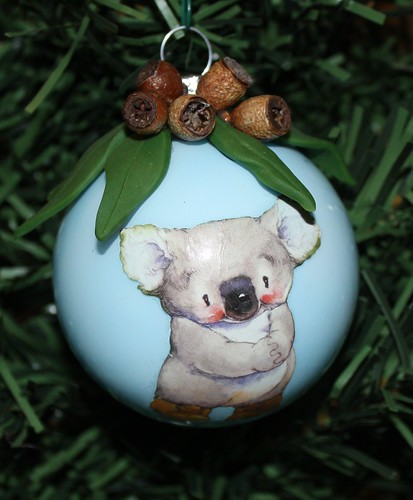The challenge this month at Christmas Crafting! was to use decoupage. I have a thing for recipe albums at the moment, and when I went through my stash and rediscovered my Santa's Village Collection by Laurie Furnell, I knew I wanted to make a recipe album with her gorgeous artwork.
To start I printed off four copies of the cookie factory image and sealed the back of them with Liquitex Gloss Medium (Modge Podge will do the same thing). This is important because the Liquid Scrap Dots that I used for dimension is essentially the same stuff as silicone and will leach through the back of unsealed paper leaving a dark spot.
Once sealed, I set aside one image to be used as the base and then cut up each of the remaining three images for layering. Most kits purchased today have done the guess work for you, but it's not that hard to look at an image and think about the perspective and then cut out what will be the background, middle and foreground.

I didn't get too intensive with the layering as this is a functional item and I didn't want either too much height, or fiddly bits that might drop off when the album is used.
The yellow frame I made with scrap cuts of chipboard adhered together in two layers, and then covered it all with Jo Sonja Texture Paste. This is a thick, white paste that lets you create dimension, in this case I used it to make the frame look like it was covered in frosting. Once dry I painted with acrylic paints and dusted with glitter.

Once the image and frame were ready it was just a matter of assembling them onto the cover. The front and back covers are thick chipboard covered with papers included in the Santa's Village kit, and the interior pages are all cut from plain Kraft card. I inked the edges of all of the pages with white ink to give it a 'dusted' appearance, and then used the Zutter to punch and bind it all together.

The recipe card was created using Word and the elements from the Santa's Village kit. There are 18 pages in the album in total, 9 of which have the recipe card on the front and back, and the remaining 9 have been decorated with either white rick rack to simulate the icing on gingerbread, or with ribbon and 'gumdrop buttons'. I left 9 blank pages so that the recipient could either put in photographs or use it as a scrap book and glue in recipes found in magazines.

The finishing touch was to decorate the wire binding with ribbons and fibres. Don't tell anyone but this hides any imperfections in the binding!

I hope I have inspired you to go and create something fabulous using the decoupage technique. Remember you don't need to purchase special kits, just find an image that you like and use your own perspective to create dimension.
Linking this up at Make It Monday: Challenge #113
Linking this up at Make It Monday: Challenge #113
















